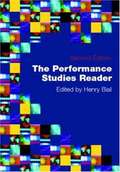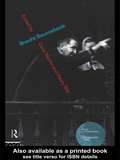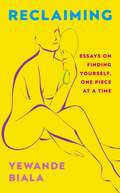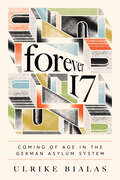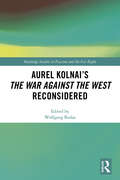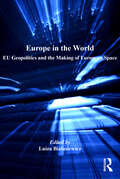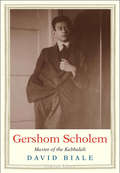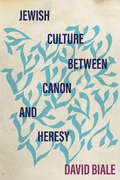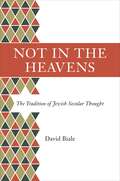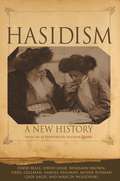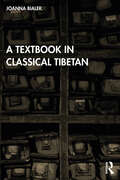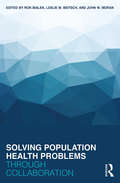- Table View
- List View
The Performance Studies Reader (PDF)
by Henry Bial Sara BradyFollowing on from the highly successful first anthology of critical and theoretical writings on performance studies, this is an updated and significantly expanded second edition which brings the anthology up to date with current debate. The new edition contains expanded introductory essays, eight entirely new pieces, and is cross-referenced with Richard Schechner's second edition of Performance Studies: An Introduction. The two volumes combine perfectly to offer a unique and complete teaching resource. This important collection is also widely used by students and scholars around the world as a stand-alone text, offering a stimulating introduction to the crucial debates of performance studies. Collecting together key critical pieces, the Reader provides an overview of the full range of performance theory for undergraduates at all levels, and beginning graduate students in performance studies, theatre, performing arts and cultural studies.
Brecht Sourcebook (Worlds of Performance)
by Henry Bial Carol MartinBertolt Brecht is one of the most prolific and influential writer-directors of the twentieth century. This fascinating anthology brings together in one volume many of the most important articles written about Brecht between 1957 and 1997. The collection explores a wide range of viewpoints about Brecht's theatre theories and practice, as well as including three plays not otherwise available in English: The Beggar or The Dead Dog, Baden Lehrstuck and The Seven Deadly Sins of the Lower Middle Class. Editors Martin and Bial have brought together a unique compendium which covers all the key areas including: * the development of Brecht's aesthetic theories * the relationship of Epic theatre to orthodox dramatic theatre * Brecht's collaboration with Kurt Weill, Paul Dessau and Max Frisch * Brecht's influence on a variety of cultures and contexts including England, Italy , Moscow and Japan. Together these essays are an ideal companion to Brecht's plays, and provide an invaluable reconsideration of Brecht's work. Contributors include: Werner Hecht, Mordecai Gorelik, Eric Bentley, Jean-Paul Sartre, Kurt Weill, Ernst Bloch, Darko Suvin, Carl Weber, Paul Dessau, Denis Calandra, W. Stuart McDowell, Ernst Schmacher, Hans-Joachim Bunge, Martin Esslin, Artuto Lazzari, Tadashi Uchino, Diana Taylor, Elin Diamond, and Lee Baxandall.
Brecht Sourcebook (Worlds of Performance)
by Henry Bial Carol MartinBertolt Brecht is one of the most prolific and influential writer-directors of the twentieth century. This fascinating anthology brings together in one volume many of the most important articles written about Brecht between 1957 and 1997. The collection explores a wide range of viewpoints about Brecht's theatre theories and practice, as well as including three plays not otherwise available in English: The Beggar or The Dead Dog, Baden Lehrstuck and The Seven Deadly Sins of the Lower Middle Class. Editors Martin and Bial have brought together a unique compendium which covers all the key areas including: * the development of Brecht's aesthetic theories * the relationship of Epic theatre to orthodox dramatic theatre * Brecht's collaboration with Kurt Weill, Paul Dessau and Max Frisch * Brecht's influence on a variety of cultures and contexts including England, Italy , Moscow and Japan. Together these essays are an ideal companion to Brecht's plays, and provide an invaluable reconsideration of Brecht's work. Contributors include: Werner Hecht, Mordecai Gorelik, Eric Bentley, Jean-Paul Sartre, Kurt Weill, Ernst Bloch, Darko Suvin, Carl Weber, Paul Dessau, Denis Calandra, W. Stuart McDowell, Ernst Schmacher, Hans-Joachim Bunge, Martin Esslin, Artuto Lazzari, Tadashi Uchino, Diana Taylor, Elin Diamond, and Lee Baxandall.
Reclaiming: Essays on finding yourself one piece at a time
by Yewande BialaReclaiming is a brilliantly written and thought-provoking book. Through amazing story telling, Yewande highlights the richness in her culture that so many other black women can relate to. It was extremely gripping right from beginning. -- Oloni'This book highlights the topics and issues we still face in our society daily, including some that I've struggled with myself. I think it's hugely important we keep having these conversations and this book certainly helps do just that.' -- Olivia Bowen'Reclaiming is comforting, yet inspiring. Yewande has admirably opened up about her experiences growing up and facing difficulties such as colourism and mental health problems, how she's so bravely over come them and found her voice. I whole heartedly recommend this book to anyone mixed up in this complex generation looking for a relatable, authentic and aspirational read.' -- Demi Jones'I absolutely loved it. I think it's clear to anyone who's read Yewande's earlier essay that she's a phenomenal writer and talent, and this is an incredible debut. Empowering, instructive, loving & honest...the kind of text that makes me excited to be a reader' -- Beth McColl'I'm so proud of the strong, intelligent woman Yewande is. She is using her platform and own experiences to educate, inspire, empower and to help others!' -- Amy Hart'A beautiful book - very relatable... a beautiful form of art.' -- Murad Merali'Reclaiming is more than just a book title. It's a statement. It's power. It's an announcement. It's a force I feel Yewande is making on behalf of all men and women of colour. Thank you Yewande.' -- Rachel Finni_____________________________________________________I am more than enough, and I am perfect with all my imperfections.In 2021, Yewande Biala wrote a searing viral essay on the debilitating effects of having your name constantly mispronounced or changed.From the incredible response to the essay, it was clear that there are still so many conversations to be had around the way that we as a society respond to each other, and the direct effect it is having on our sense of self. Reclaiming consists of interlinked essays covering a wide breadth of topics from struggling with your body image and mental health to navigating social media and dating apps without damaging your self-esteem.Each essay covers a different topic, affirming that maintaining your sense of self in a world that is not supportive of you is difficult, but not impossible. Nuanced, distinctly sharp, and full of wit, Reclaiming holds a mirror up to us all, and encourages us to like what we see.
Forever 17: Coming of Age in the German Asylum System (Ethnographic Encounters and Discoveries)
by Ulrike BialasAn exploration of how age affects the experience and life prospects of asylum-seekers in Germany. Heartbreaking images of children in distress have propelled some of the most urgent calls for action on immigration crises, and that compassion often affects how state asylum policies are structured. In Germany, for example, the immigration system is engineered to protect minors, which leads to unintended consequences for migrants. In Forever 17, Ulrike Bialas follows young African and Central Asian migrants in Germany as they navigate that system. Without official paperwork or even, in many cases, knowledge of their exact age, migrants must decide how to present their complicated life stories to government officials. They quickly realize that their age can have an outsized effect on the outcome of their cases. A migrant under 18, for example, can’t be deported, but might instead be placed in a youth home, where they will be subject to strict curfew laws. An 18-year-old adult, on the other hand, can get permission to work, but not opportunities to go to school. Regardless of their age—actual or assumed—migrants face great difficulties. Those classified as minors must live with the psychological burden of being treated like children, while those classified as adults must live without the practical support and legal protections reserved for minors. The significance of age stands in stark contrast to the ambiguities inherent in its determination. Though Germany’s infamous bureaucracy is designed to issue clear statements about refugees and migrants, the truth is often more complicated, and officials are forced to grapple with the difficult implications of their decisions. Ultimately, Bialas shows, policies surrounding asylum seekers fall dramatically short of their humanitarian ideals. Even those policies designed to help the most vulnerable can lead to outcomes that drastically limit the possibilities for migrants in real need of protection and keep them from leading fulfilling lives.
Forever 17: Coming of Age in the German Asylum System (Ethnographic Encounters and Discoveries)
by Ulrike BialasAn exploration of how age affects the experience and life prospects of asylum-seekers in Germany. Heartbreaking images of children in distress have propelled some of the most urgent calls for action on immigration crises, and that compassion often affects how state asylum policies are structured. In Germany, for example, the immigration system is engineered to protect minors, which leads to unintended consequences for migrants. In Forever 17, Ulrike Bialas follows young African and Central Asian migrants in Germany as they navigate that system. Without official paperwork or even, in many cases, knowledge of their exact age, migrants must decide how to present their complicated life stories to government officials. They quickly realize that their age can have an outsized effect on the outcome of their cases. A migrant under 18, for example, can’t be deported, but might instead be placed in a youth home, where they will be subject to strict curfew laws. An 18-year-old adult, on the other hand, can get permission to work, but not opportunities to go to school. Regardless of their age—actual or assumed—migrants face great difficulties. Those classified as minors must live with the psychological burden of being treated like children, while those classified as adults must live without the practical support and legal protections reserved for minors. The significance of age stands in stark contrast to the ambiguities inherent in its determination. Though Germany’s infamous bureaucracy is designed to issue clear statements about refugees and migrants, the truth is often more complicated, and officials are forced to grapple with the difficult implications of their decisions. Ultimately, Bialas shows, policies surrounding asylum seekers fall dramatically short of their humanitarian ideals. Even those policies designed to help the most vulnerable can lead to outcomes that drastically limit the possibilities for migrants in real need of protection and keep them from leading fulfilling lives.
Aurel Kolnai's The War AGAINST the West Reconsidered (Routledge Studies in Fascism and the Far Right)
by Wolfgang BialasAurel Kolnai’s The War against the West remains one of the most insightful analyses of Nazi thought ever written. First published in 1938 it was a revelation for many readers. Quite different in tone and approach from most other analyses of Nazism available in English, it was remarkable for the thoroughness with which it discussed the writings of Nazi thinkers and for the seriousness with which it took their views. In this edited collection published eighty years after the original book, a team of distinguished scholars reassess this classic text and also consider its continued relevance to contemporary politics. They address issues such as the comparison of Nazism and communism, anti-Semitism, British and American perceptions of the Reich before the war and the Nazi legal theory of Carl Schmitt. This book is a vital source for historians of Nazism and Fascism.
Aurel Kolnai's The War AGAINST the West Reconsidered (Routledge Studies in Fascism and the Far Right)
by Wolfgang BialasAurel Kolnai’s The War against the West remains one of the most insightful analyses of Nazi thought ever written. First published in 1938 it was a revelation for many readers. Quite different in tone and approach from most other analyses of Nazism available in English, it was remarkable for the thoroughness with which it discussed the writings of Nazi thinkers and for the seriousness with which it took their views. In this edited collection published eighty years after the original book, a team of distinguished scholars reassess this classic text and also consider its continued relevance to contemporary politics. They address issues such as the comparison of Nazism and communism, anti-Semitism, British and American perceptions of the Reich before the war and the Nazi legal theory of Carl Schmitt. This book is a vital source for historians of Nazism and Fascism.
Europe in the World: EU Geopolitics and the Making of European Space
by Luiza BialasiewiczThis edited volume provides an innovative contribution to the debate on contemporary European geopolitics by tracing some of the new political geographies and geographical imaginations emergent within - and made possible by - the EU's actions in the international arena. Drawing on case studies that range from the Arctic to East Africa, the nine empirical chapters provide a critical geopolitical reading of the ways in which particular places, countries, and regions are brought into the EU's orbit and the ways in which they are made to work for 'EU'rope. The analyses look at how the spaces of 'EU'ropean power and actorness are narrated and created, but also at how 'EU'rope's discursive (and material) strategies of incorporation are differently appropriated by local and regional elites, from the southern shores of the Mediterranean to Eastern Europe and the Balkans. The question of EU border management is a particularly important concern of several contributions, highlighting some of the ways in which the Union's border-work is actively (re)making the European space.
Europe in the World: EU Geopolitics and the Making of European Space (Critical Geopolitics Ser.)
by Luiza BialasiewiczThis edited volume provides an innovative contribution to the debate on contemporary European geopolitics by tracing some of the new political geographies and geographical imaginations emergent within - and made possible by - the EU's actions in the international arena. Drawing on case studies that range from the Arctic to East Africa, the nine empirical chapters provide a critical geopolitical reading of the ways in which particular places, countries, and regions are brought into the EU's orbit and the ways in which they are made to work for 'EU'rope. The analyses look at how the spaces of 'EU'ropean power and actorness are narrated and created, but also at how 'EU'rope's discursive (and material) strategies of incorporation are differently appropriated by local and regional elites, from the southern shores of the Mediterranean to Eastern Europe and the Balkans. The question of EU border management is a particularly important concern of several contributions, highlighting some of the ways in which the Union's border-work is actively (re)making the European space.
Gershom Scholem: Master of the Kabbalah (Jewish Lives)
by David BialeA new biography of the seminal twentieth-century historian and thinker who pioneered the study of Jewish mysticism and profoundly influenced the Zionist movement Gershom Scholem (1897–1982) was perhaps the foremost Jewish intellectual of the twentieth century. Pioneering the study of Jewish mysticism as a legitimate academic discipline, he overturned the rationalist bias of his predecessors and revealed an extraordinary world of myth and messianism. In his youth, he rebelled against the assimilationist culture of his parents and embraced Zionism as the vehicle for the renewal of Judaism in a secular age. He moved to Palestine in 1923 and participated in the creation of the Hebrew University, where he was a towering figure for nearly seventy years. David Biale traces Scholem’s tumultuous life of political activism and cultural criticism, including his falling-out with Hannah Arendt over the Eichmann trial. Mining a rich trove of diaries, letters, and other writings, Biale shows that his subject’s inner life illuminates his most important writings. Scholem emerges as a passionately engaged man of his times—a period that encompassed two world wars, the rise of Nazism, and the Holocaust.
Jewish Culture between Canon and Heresy (Stanford Studies in Jewish History and Culture)
by David BialeThis career-spanning anthology from prominent Jewish historian David Biale brings over a dozen of his key essays together for the first time. These pieces, written between 1974 and 2016, are all representative of a method Biale calls "counter-history": "the discovery of vital forces precisely in what others considered marginal, disreputable and irrational." The themes that have preoccupied Biale throughout the course of his distinguished career—in particular power, sexuality, blood, and secular Jewish thought—span the periods of the Bible, late antiquity, and the Middle Ages to the twentieth century. Exemplary essays in this volume argue for the dialectical relationship between modernity and its precursors in the older tradition, working together to "brush history against the grain" in order to provide a sweeping look at the history of the Jewish people. This volume of work by one of the boldest and most intellectually omnivorous Jewish thinkers of our time will be essential reading for scholars and students of Jewish studies.
Jewish Culture between Canon and Heresy (Stanford Studies in Jewish History and Culture)
by David BialeThis career-spanning anthology from prominent Jewish historian David Biale brings over a dozen of his key essays together for the first time. These pieces, written between 1974 and 2016, are all representative of a method Biale calls "counter-history": "the discovery of vital forces precisely in what others considered marginal, disreputable and irrational." The themes that have preoccupied Biale throughout the course of his distinguished career—in particular power, sexuality, blood, and secular Jewish thought—span the periods of the Bible, late antiquity, and the Middle Ages to the twentieth century. Exemplary essays in this volume argue for the dialectical relationship between modernity and its precursors in the older tradition, working together to "brush history against the grain" in order to provide a sweeping look at the history of the Jewish people. This volume of work by one of the boldest and most intellectually omnivorous Jewish thinkers of our time will be essential reading for scholars and students of Jewish studies.
Not in the Heavens: The Tradition of Jewish Secular Thought
by David BialeNot in the Heavens traces the rise of Jewish secularism through the visionary writers and thinkers who led its development. Spanning the rich history of Judaism from the Bible to today, David Biale shows how the secular tradition these visionaries created is a uniquely Jewish one, and how the emergence of Jewish secularism was not merely a response to modernity but arose from forces long at play within Judaism itself. Biale explores how ancient Hebrew books like Job, Song of Songs, and Esther downplay or even exclude God altogether, and how Spinoza, inspired by medieval Jewish philosophy, recast the biblical God in the role of nature and stripped the Torah of its revelatory status to instead read scripture as a historical and cultural text. Biale examines the influential Jewish thinkers who followed in Spinoza's secularizing footsteps, such as Salomon Maimon, Heinrich Heine, Sigmund Freud, and Albert Einstein. He tells the stories of those who also took their cues from medieval Jewish mysticism in their revolts against tradition, including Hayim Nahman Bialik, Gershom Scholem, and Franz Kafka. And he looks at Zionists like David Ben-Gurion and other secular political thinkers who recast Israel and the Bible in modern terms of race, nationalism, and the state. Not in the Heavens demonstrates how these many Jewish paths to secularism were dependent, in complex and paradoxical ways, on the very religious traditions they were rejecting, and examines the legacy and meaning of Jewish secularism today.
Not in the Heavens: The Tradition of Jewish Secular Thought
by David BialeNot in the Heavens traces the rise of Jewish secularism through the visionary writers and thinkers who led its development. Spanning the rich history of Judaism from the Bible to today, David Biale shows how the secular tradition these visionaries created is a uniquely Jewish one, and how the emergence of Jewish secularism was not merely a response to modernity but arose from forces long at play within Judaism itself. Biale explores how ancient Hebrew books like Job, Song of Songs, and Esther downplay or even exclude God altogether, and how Spinoza, inspired by medieval Jewish philosophy, recast the biblical God in the role of nature and stripped the Torah of its revelatory status to instead read scripture as a historical and cultural text. Biale examines the influential Jewish thinkers who followed in Spinoza's secularizing footsteps, such as Salomon Maimon, Heinrich Heine, Sigmund Freud, and Albert Einstein. He tells the stories of those who also took their cues from medieval Jewish mysticism in their revolts against tradition, including Hayim Nahman Bialik, Gershom Scholem, and Franz Kafka. And he looks at Zionists like David Ben-Gurion and other secular political thinkers who recast Israel and the Bible in modern terms of race, nationalism, and the state. Not in the Heavens demonstrates how these many Jewish paths to secularism were dependent, in complex and paradoxical ways, on the very religious traditions they were rejecting, and examines the legacy and meaning of Jewish secularism today.
Hasidism: A New History
by David Biale David Assaf Benjamin Brown Uriel Gellman Samuel Heilman Moshe Rosman Gadi Sagiv Marcin WodzińskiThe first comprehensive history of the pietistic movement that shaped modern JudaismThis is the first comprehensive history of the pietistic movement that shaped modern Judaism. The book’s unique blend of intellectual, religious, and social history offers perspectives on the movement’s leaders as well as its followers, and demonstrates that, far from being a throwback to the Middle Ages, Hasidism is a product of modernity that forged its identity as a radical alternative to the secular world.Hasidism originated in southeastern Poland, in mystical circles centered on the figure of Israel Ba'al Shem Tov, but it was only after his death in 1760 that a movement began to spread. Challenging the notion that Hasidism ceased to be a creative movement after the eighteenth century, this book argues that its first golden age was in the nineteenth century, when it conquered new territory, won a mass following, and became a mainstay of Jewish Orthodoxy. World War I, the Russian Revolution, and the Holocaust decimated eastern European Hasidism. But following World War II, the movement enjoyed a second golden age, growing exponentially. Today, it is witnessing a remarkable renaissance in Israel, the United States, and other countries around the world.Written by an international team of scholars, Hasidism is a must-read for anyone seeking to understand this vibrant and influential modern Jewish movement.
Hasidism: A New History
by David Biale David Assaf Benjamin Brown Uriel Gellman Samuel Heilman Moshe Rosman Gadi Sagiv Marcin WodzińskiThe first comprehensive history of the pietistic movement that shaped modern JudaismThis is the first comprehensive history of the pietistic movement that shaped modern Judaism. The book’s unique blend of intellectual, religious, and social history offers perspectives on the movement’s leaders as well as its followers, and demonstrates that, far from being a throwback to the Middle Ages, Hasidism is a product of modernity that forged its identity as a radical alternative to the secular world.Hasidism originated in southeastern Poland, in mystical circles centered on the figure of Israel Ba'al Shem Tov, but it was only after his death in 1760 that a movement began to spread. Challenging the notion that Hasidism ceased to be a creative movement after the eighteenth century, this book argues that its first golden age was in the nineteenth century, when it conquered new territory, won a mass following, and became a mainstay of Jewish Orthodoxy. World War I, the Russian Revolution, and the Holocaust decimated eastern European Hasidism. But following World War II, the movement enjoyed a second golden age, growing exponentially. Today, it is witnessing a remarkable renaissance in Israel, the United States, and other countries around the world.Written by an international team of scholars, Hasidism is a must-read for anyone seeking to understand this vibrant and influential modern Jewish movement.
Hasidism: A New History
by David Biale David Assaf Benjamin Brown Uriel Gellman Samuel Heilman Moshe Rosman Gadi Sagiv Marcin Wodziński Arthur GreenThe first comprehensive history of the pietistic movement that shaped modern JudaismThis is the first comprehensive history of the pietistic movement that shaped modern Judaism. The book’s unique blend of intellectual, religious, and social history offers perspectives on the movement’s leaders as well as its followers, and demonstrates that, far from being a throwback to the Middle Ages, Hasidism is a product of modernity that forged its identity as a radical alternative to the secular world.Hasidism originated in southeastern Poland, in mystical circles centered on the figure of Israel Ba'al Shem Tov, but it was only after his death in 1760 that a movement began to spread. Challenging the notion that Hasidism ceased to be a creative movement after the eighteenth century, this book argues that its first golden age was in the nineteenth century, when it conquered new territory, won a mass following, and became a mainstay of Jewish Orthodoxy. World War I, the Russian Revolution, and the Holocaust decimated eastern European Hasidism. But following World War II, the movement enjoyed a second golden age, growing exponentially. Today, it is witnessing a remarkable renaissance in Israel, the United States, and other countries around the world.Written by an international team of scholars, Hasidism is a must-read for anyone seeking to understand this vibrant and influential modern Jewish movement.
Hasidism: A New History
by David Biale David Assaf Benjamin Brown Uriel Gellman Samuel Heilman Moshe Rosman Gadi Sagiv Marcin Wodziński Arthur GreenThe first comprehensive history of the pietistic movement that shaped modern JudaismThis is the first comprehensive history of the pietistic movement that shaped modern Judaism. The book’s unique blend of intellectual, religious, and social history offers perspectives on the movement’s leaders as well as its followers, and demonstrates that, far from being a throwback to the Middle Ages, Hasidism is a product of modernity that forged its identity as a radical alternative to the secular world.Hasidism originated in southeastern Poland, in mystical circles centered on the figure of Israel Ba'al Shem Tov, but it was only after his death in 1760 that a movement began to spread. Challenging the notion that Hasidism ceased to be a creative movement after the eighteenth century, this book argues that its first golden age was in the nineteenth century, when it conquered new territory, won a mass following, and became a mainstay of Jewish Orthodoxy. World War I, the Russian Revolution, and the Holocaust decimated eastern European Hasidism. But following World War II, the movement enjoyed a second golden age, growing exponentially. Today, it is witnessing a remarkable renaissance in Israel, the United States, and other countries around the world.Written by an international team of scholars, Hasidism is a must-read for anyone seeking to understand this vibrant and influential modern Jewish movement.
Hasidism: A New History
by David Biale David Assaf Benjamin Brown Uriel Gellman Samuel Heilman Moshe Rosman Gadi Sagiv Marcin Wodziński Arthur GreenThe first comprehensive history of the pietistic movement that shaped modern JudaismThis is the first comprehensive history of the pietistic movement that shaped modern Judaism. The book’s unique blend of intellectual, religious, and social history offers perspectives on the movement’s leaders as well as its followers, and demonstrates that, far from being a throwback to the Middle Ages, Hasidism is a product of modernity that forged its identity as a radical alternative to the secular world.Hasidism originated in southeastern Poland, in mystical circles centered on the figure of Israel Ba'al Shem Tov, but it was only after his death in 1760 that a movement began to spread. Challenging the notion that Hasidism ceased to be a creative movement after the eighteenth century, this book argues that its first golden age was in the nineteenth century, when it conquered new territory, won a mass following, and became a mainstay of Jewish Orthodoxy. World War I, the Russian Revolution, and the Holocaust decimated eastern European Hasidism. But following World War II, the movement enjoyed a second golden age, growing exponentially. Today, it is witnessing a remarkable renaissance in Israel, the United States, and other countries around the world.Written by an international team of scholars, Hasidism is a must-read for anyone seeking to understand this vibrant and influential modern Jewish movement.
Hasidism: A New History
by David Biale Arthur Green Moshe Rosman David Assaf Samuel Heilman Benjamin Brown Uriel Gellman Gadi Sagiv Marcin WodzińskiThe first comprehensive history of the pietistic movement that shaped modern JudaismThis is the first comprehensive history of the pietistic movement that shaped modern Judaism. The book’s unique blend of intellectual, religious, and social history offers perspectives on the movement’s leaders as well as its followers, and demonstrates that, far from being a throwback to the Middle Ages, Hasidism is a product of modernity that forged its identity as a radical alternative to the secular world.Hasidism originated in southeastern Poland, in mystical circles centered on the figure of Israel Ba'al Shem Tov, but it was only after his death in 1760 that a movement began to spread. Challenging the notion that Hasidism ceased to be a creative movement after the eighteenth century, this book argues that its first golden age was in the nineteenth century, when it conquered new territory, won a mass following, and became a mainstay of Jewish Orthodoxy. World War I, the Russian Revolution, and the Holocaust decimated eastern European Hasidism. But following World War II, the movement enjoyed a second golden age, growing exponentially. Today, it is witnessing a remarkable renaissance in Israel, the United States, and other countries around the world.Written by an international team of scholars, Hasidism is a must-read for anyone seeking to understand this vibrant and influential modern Jewish movement.
A Textbook in Classical Tibetan
by Joanna BialekA Textbook in Classical Tibetan is the first comprehensive course book in the Classical Tibetan language written in English. The textbook describes the grammar of pre-16th-century Classical Tibetan works for beginners and students of intermediate level. It is intended to cover the most essential topics that can be mastered within two semesters of an academic class. Classical Tibetan is a written Middle Tibetan language that has been in use in Tibet from the 9th century. Until the early 20th century it served all purposes, from administrative, to medical, to religious. Nowadays Classical Tibetan remains an important part of religious identity and services for communities also outside of cultural Tibet, foremost in India, Nepal, and Bhutan, but also elsewhere, most importantly in Europe, North America and Australia. The main body of the textbook consists of an introduction to the Tibetan script, eighteen lessons, and a reading section. Each lesson elucidates several grammatical topics which are followed by an exercise and a word list. The chapter readings contain four supplementary readings. In addition to the main parts of the textbook, a brief introduction to Tibetic languages provides linguistic context for the language taught in the textbook, whereas the chapter Translations of Exercises and Readings contains translations and explanatory notes to the exercises provided at the end of each lesson, as well as to the readings. A Textbook in Classical Tibetan is essential reading for both undergraduate and graduate students without any knowledge of Classical Tibetan, but also for those who would like to deepen their experience of the language by reading annotated excerpts from well-known pieces of Tibetan literature.
A Textbook in Classical Tibetan
by Joanna BialekA Textbook in Classical Tibetan is the first comprehensive course book in the Classical Tibetan language written in English. The textbook describes the grammar of pre-16th-century Classical Tibetan works for beginners and students of intermediate level. It is intended to cover the most essential topics that can be mastered within two semesters of an academic class. Classical Tibetan is a written Middle Tibetan language that has been in use in Tibet from the 9th century. Until the early 20th century it served all purposes, from administrative, to medical, to religious. Nowadays Classical Tibetan remains an important part of religious identity and services for communities also outside of cultural Tibet, foremost in India, Nepal, and Bhutan, but also elsewhere, most importantly in Europe, North America and Australia. The main body of the textbook consists of an introduction to the Tibetan script, eighteen lessons, and a reading section. Each lesson elucidates several grammatical topics which are followed by an exercise and a word list. The chapter readings contain four supplementary readings. In addition to the main parts of the textbook, a brief introduction to Tibetic languages provides linguistic context for the language taught in the textbook, whereas the chapter Translations of Exercises and Readings contains translations and explanatory notes to the exercises provided at the end of each lesson, as well as to the readings. A Textbook in Classical Tibetan is essential reading for both undergraduate and graduate students without any knowledge of Classical Tibetan, but also for those who would like to deepen their experience of the language by reading annotated excerpts from well-known pieces of Tibetan literature.
Solving Population Health Problems through Collaboration
by Ron Bialek Leslie M. Beitsch John W. MoranRapid changes in healthcare and public health offer tremendous opportunities to focus on process improvement. Public health departments and agencies increasingly work collaboratively with hospitals and other community partners to promote knowledge and improve collective impact through public and private sector coalitions. Solving Population Health Problems through Collaboration brings together population health experts and leaders to examine evidence-based intervention strategies, case studies in health departments and hospitals, health equity issues, core competencies, public health campaigns, step-by-step collaboration advice, and much more. Each chapter is written by a population health leader shaped by his or her experience implementing change in a community’s health, to demonstrate innovative methods and tools for building and leading sustainable community coalitions to effect real change. Designed to prepare population health workers in public health and healthcare settings to develop strategies for improved population health, this book is required reading for public health managers and health administrators as well as students enrolled in population health courses.
Solving Population Health Problems through Collaboration
by Ron Bialek Leslie M. Beitsch John W. MoranRapid changes in healthcare and public health offer tremendous opportunities to focus on process improvement. Public health departments and agencies increasingly work collaboratively with hospitals and other community partners to promote knowledge and improve collective impact through public and private sector coalitions. Solving Population Health Problems through Collaboration brings together population health experts and leaders to examine evidence-based intervention strategies, case studies in health departments and hospitals, health equity issues, core competencies, public health campaigns, step-by-step collaboration advice, and much more. Each chapter is written by a population health leader shaped by his or her experience implementing change in a community’s health, to demonstrate innovative methods and tools for building and leading sustainable community coalitions to effect real change. Designed to prepare population health workers in public health and healthcare settings to develop strategies for improved population health, this book is required reading for public health managers and health administrators as well as students enrolled in population health courses.
